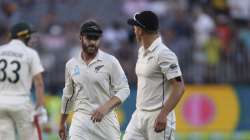Australia extend lead in day-night Test against New Zealand despite wicket-laden floodlight session
Despite Australia’s second innings collapse from a seemingly comfortable 131-2, New Zealand is facing a big target and starring at a heavy defeat in the first of the three tests.

Australia has a stranglehold on the opening test match against New Zealand after taking a 417-run lead on a wicket that is getting increasingly difficult to bat on under the lights at Perth Stadium.
After New Zealand was skittled out for 166 at lunch on day three in response to Australia’s 416, the home side refused to enforce the follow-on and batted again, finishing the day on 167-6 with Matthew Wade and Pat Cummins unbeaten on eight and one runs, respectively.
Despite Australia’s second innings collapse from a seemingly comfortable 131-2, New Zealand is facing a big target and starring at a heavy defeat in the first of the three tests.
Swing bowlers Tim Southee (4-63) and Neil Wagner (2-40) struck just as Australia’s Mitchell Starc did the previous night as the home side lost 5-29 in 66 deliveries.
This dented Australia’s hope to bat deep into the fourth day before unleashing its pace attack under the lights when the pink ball is most effective. Also, the pitch has deteriorated much quicker than anticipated in the hot conditions with innocuous bounces being regular as seen during the Australian second innings.
David Warner (19) uncharacteristically failed twice following 154 and 335 not out in his last two outings in the 2-0 series wining over Pakistan.
After Warner fell, Burns (53) and Labuschagne (50) shared 87 for the second wicket before Australia’s newest batting find miscued a pull and was caught at mid, triggering the middle-order collapse.
Labuschagne took his run tally to 1,022 (average 73.00) to become the first batsman in the 2019 calendar year to complete 1,000 test runs. He reached the mark in his 10th test since being recalled as a concussion substitute for Steve Smith in the second Ashes test in England. He hit three consecutive centuries including 143 in the first innings to add to five half centuries.
Warner lived a charmed life for over an hour facing 63 ball before miscuing a pull of Tim Southee and was caught at mid on. He survived a review for a catch behind on 15 and on 17 narrowly escaped a run out.
During the innings Warner, playing his 82nd test, became the 12th Australian batsman to amass 7,000 runs in test cricket. He brought up the milestone with a cover driven boundary off Southee.
Despite the 250-run first innings lead, Australia was wary of bowling the second time as the temperature topped 40 Celsius (107 F) for the third day in a row. This was in addition to being a bowler short with swing bowler Josh Hazlewood ruled out of the match with a hamstring strain.
Earlier, fast bowler Starc took 5-52 — his third five-wicket innings in seven day-night tests and his 13th overall in 55 tests — to hurry New Zealand’s batting demise.
After slicing through the New Zealand top order with four wickets on the second evening, Starc claimed his fifth wicket controversially when de Grandhomme was adjudged caught by on-field umpire Aleem Dar and upheld by review.
De Grandhomme pulled a couple of boundaries off Starc, and two balls later, tried to fend a short pitch delivery that hit the face of the helmet before Steve Smith at second slip caught it. De Grandhomme reviewed Dar’s decision only to be upheld despite a series of inconclusive replays.
Ross Taylor top scored for New Zealand with an unblemished 80 runs and stood between New Zealand and the hosts with a 134-ball innings over 2 ½ hours hitting nine boundaries before offspinner Nathan Lyon (2-48) forced an edge and Smith at slip took his third catch.
The only other notable contribution came from skipper Kane Williamson (34) before he was brilliantly caught by Smith at second slip to end a fighting 76-run third wicket stand. In the second evening.
The New Zealand innings lasted 55.2 overs over 262 minutes while the Australian first innings consumed 10 ¼ hours and 146.2 overs.